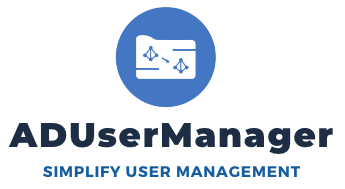Create New Users
Users not already found in AD will be created automatically using rules you specify.
Push Changes
If the AD account exists already ADU will push changes, such as changes to department, title, location, etc.
Disable/Delete
If the user is flagged with a termination date, we can disable the account and optionally delete it after a specified period of time.

Introducing ADUserManager: Simplify User Management in Active Directory with PowerShell
ADUserManager is a powerful PowerShell library designed to streamline user management in Active Directory (AD) by leveraging data from an external system. With ADUserManager, you can effortlessly create, update, or terminate user accounts based on information stored in a text file, providing a seamless integration between your corporate system of record and AD.
Key Features:
- Easy Data Integration: ADUserManager enables you to extract user data from a text file, eliminating the need for manual data entry and reducing the chances of errors. This integration ensures that user information remains consistent and up-to-date across your corporate ecosystem.
- Automated User Provisioning: The module automates the process of creating new user accounts in Active Directory based on the data provided in the text file. It saves valuable time and effort by eliminating manual account creation tasks, ensuring that new employees or system users have their AD accounts ready without delays.
- Efficient User Updates: ADUserManager allows you to update existing user accounts in Active Directory based on changes in the external system. Whether it’s updating contact information, department, or any other attribute, the module ensures that the AD user records accurately reflect the latest information from your corporate system of record.
- Seamless User Termination: When an employee or user is no longer active in the external system, ADUserManager can facilitate the automated termination of their corresponding AD account. This feature improves security by promptly disabling access to corporate resources, reducing the risk of unauthorized access.
Why Sync with a Corporate System of Record?
In some organizations, the corporate system of record may serve as the primary source of truth for user-related information. This system could be an HR system, an identity management platform, or another system specifically designed for maintaining employee or user data. There are several reasons why organizations choose to use such systems instead of relying solely on Active Directory:
- Centralized Data Management: A corporate system of record allows for centralized management of user information, providing a unified and consistent view across various systems and departments. It becomes the single source for maintaining accurate and comprehensive user data.
- Enhanced Data Security: By storing sensitive user information in a dedicated system, organizations can implement stricter access controls, advanced encryption measures, and auditing mechanisms to ensure data security and compliance with privacy regulations.
- Integration with Multiple Systems: Corporate systems of record often integrate with various other applications and platforms, enabling efficient data synchronization across the organization. This integration facilitates a seamless flow of information between systems and minimizes duplication or inconsistencies.
ADUserManager bridges the gap between your corporate system of record and Active Directory, allowing you to leverage the benefits of both. By utilizing the power of PowerShell, it provides an automated and reliable solution for synchronizing user data, creating a more efficient and accurate user management process.
Simplify user provisioning, updates, and termination in Active Directory with ADUserManager. Experience streamlined user management, reduced administrative overhead, and enhanced data integrity by leveraging your corporate system of record.
Note: It is crucial to ensure that appropriate security measures are implemented to protect the integrity and confidentiality of user data throughout the synchronization process.